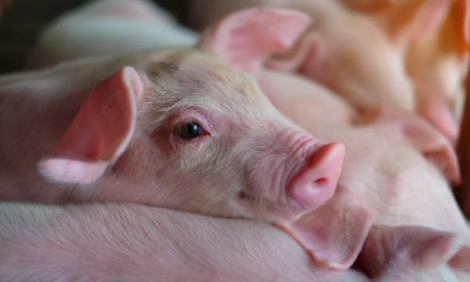



Harvesting pig manure on a conveyor belt shows promising test results
By Sam Bradshaw - Better Pork Magazine - In U.S. trials, the belt housing system proved easy to operate, resulted in good animal performance, and most importantly, yielded feces of five per cent dry matter, a clean urine stream and only one kilogram of ammonia.
Last September, five North Carolina State University researchers (I am guessing here) presented a paper at an American Society of Agricultural Engineering conference in North Carolina which describes a relatively new and quite promising way of handling hog manure. Ontario Pork, the Ontario Ministry of Agriculture and Food and the University of Guelph are researching a barn similar to the one described below, this summer. Here's a summary of what the North Carolina paper said.
Modern swine facilities have not been designed for maximization of manure value or minimization of ammonia emission. These benefits can possibly be achieved by harvesting urine and feces separately on a conveyor belt placed at an angle beneath the slats. Urine drains off this belt into a gutter leading to a closed storage vessel while feces remain on the belt. Such a belt was evaluated in a partially slatted swine facility housing 80 grower pigs. In trial 1, the optimal time of day for fecal collection and belt performance under steady state use were determined.
In trial 2, belt performance under steady state operation was tested, and animal performance was compared with that from a conventional facility.
The belt system was timer-operated, requiring no labour other than cleaning the scraper. Urine collections in trial 2 averaged 1.3 l/pig/day or 42 per cent of the water intake. Ammonia emissions were derived solely from the pen surface (unaffected by the fecal load on the belt), and thus were dependent on the defecation pattern of the animals. When defecation occurred predominantly on the slatted portion of the pen, ammonia concentrations ranged from 1.5 to 4.5 ppm. Pigs housed in the belt facility (trial 2) had a six per cent improved feed efficiency compared to those in conventional housing. In conclusion, the belt housing system was easy to operate, resulted in good animal performance, and most importantly, yielded feces of five per cent dry matter, a clean urine stream and only one kilogram of ammonia.
| Experimental Parameters and Animal Performance Data for Belt-Based Housing Trials | |||
| Trial 1 | Trial 2 Belt | Conventional Housing | |
| Entry Weight (kg/pig) | 27 | 23 | 24 |
| Exit weight (kg/pig) | 55 | 51 | 52 |
| Daily feed intake (kg/pig) | 1.52 | 1.72 * | 1.84 * |
| Daily gain (kg/pig) | 0.76 | 0.82 | 0.83 |
| Feed/gain | 1.99 | 2.09** | 2.21** |
| Fecal output (kg DM/pig/d) | 0.26 | 0.22 | ND |
| Water utilization (l/pig/d) | ND | 3.6 | 2.6 |
| Urine output (l/pig/d) | 1.1 | 1.5 | ND |
| * p < 0.10 **p <0.05 ND = Not determined | |||
Introduction. Environmental concerns with intensive swine production facilities have necessitated the re-evaluation of management practices for manure handling. Current manure management practices in the swine industry are a slatted floor with either liquid storage under the slats (slurry system) or a flush system with lagoon storage (Keener et al., 1999). These systems yield manure that usually ranges between one and 10 percent dry matter, which limits the flexibility of its application primarily due to transportation costs.
Solid/liquid separation techniques like centrifuges, tangential flow separation, settling basins and screen separators have all been used to improve manure handling because the reduction of solids in the liquid bulk facilitates pumping and handling and allows for use of the high phosphorus solids as a value-added product.
However, since all these technologies separate manure after it has been mixed and stored, they do nothing to mitigate odour and ammonia emissions within the hog house or at the storage facility. They also demonstrate a low efficiency of solids recovery from the swine manure and require higher investments for equipment, maintenance, and skills on the farm level (Westerman and Bicudo, 2000).
Conveyor belts have been successfully used to collect poultry manure for the past 30 years. This technology was adapted to swine production, placing the belt at an angle under the slatted portion of the pens. Its lower edge feeds into a pipe that collects the urine and transports it to the end of the building, thus allowing the separate collection of urine and feces within the hog house. Due to the separate collection of the manure streams, bacterial urease, present in feces, has limited opportunity to metabolize urinary urea to ammonia and CO2, thus potentially reducing ammonia emissions.
The harvesting of fecal material as dry manure also allows for easier and cheaper transport of the phosphorus-containing material, ultimately permitting greater flexibility in its application. This material can also be easily composted, gasified for energy production or transported to areas where it may be applied to land. The urine stream, containing approximately 70 per cent of the excreted N (Aarnink et al., 1993), can be used for land application, or can be processed through denitrification or ion-exchange to capture the N for use in fertilizers.
Trials with a demonstration belt housing unit were performed, 1) to evaluate the belt design; 2) to determine the pig's growth potential using the chosen partially slatted housing design; and 3) to quantify ammonia and methane emissions from the belt housing system.
Methods. For each trial, 80 pigs, barrows and gilts, were raised from 25 to 55 kilograms and housed 16 pigs per pen (2.25 x 4.5m). Penning material, feeders, and the belt were supplied by Big Dutchman (Vechta, Germany) and were two-thirds solid floor and one-third slatted floor (tri-bar). The pen size used was 75 per cent of that of a standard barn; otherwise, the same layout was used as in a standard barn. Solid partitions were used around the solid floor to direct defecation to the slatted-floor portion of the pen. Each pen also contained one wet-dry feeder in order to minimize water wastage. Animals were fed a corn-soybean meal grower ration with 17 per cent crude protein.
A one-millimetre-thick polypropylene conveyor belt was installed beneath the slatted area. The belt was placed at a four-degree angle, side to side, to facilitate liquid drainage into the gutter running the length of the belt (Figure 1). The belt was also sloped one degree along its length, allowing urine to drain continuously into a closed collection vessel at the end of the belt.
Trial 1 was conducted solely in the belt demonstration housing facility. For trial 2, however, pigs were assigned either to the belt demonstration facility or to the conventional housing unit at the NC State University swine farm. Animals from a single source were weight-matched, distributed between the two facilities, housed at the same stocking density and fed the same ration.
Ammonia and methane concentrations in the exhaust air from the belt housing facility were analyzed by a process called Fourier Transform Infrared Spectroscopy FTIR; van Kempen, 2001).
Results. The belt was operated automatically from a timer and ran unattended. It performed trouble-free in all trials. The only manual action required was the daily cleaning of the belt-scraper, which takes approximately one minute per belt (depending on accessibility). During this time, belt tracking was verified and no problems were observed throughout the course of the trials.
Animal performance was comparable in both trials, with an average daily gain of 0.79 kg/pig/day and a feed efficiency of 2.04 (see Table 1). The total manure produced per pig during the trials was 0.24 kg/day on a dry matter basis (suggesting an 83 per cent digestibility of feed dry matter. Collected urine averaged 1.3 liters per pig per day, or 42 per cent of the water intake. This urine appeared to have little fecal contamination, based on color and clarity, but was somewhat concentrated due to evaporation.
Fecal dry matter was strongly affected by the time of day at which the belt was run. The data suggest that early morning collections are best. This may be due to the observation that little urine is deposited on the belt at night, thus allowing the feces to dry more completely.
Dry matter exhibited a sigmoidal pattern with early morning collections resulting in the driest manure, likely linked to the diurnal urination pattern of the pigs.
Ammonia emissions were monitored semi-continuously during the steady-state collection period in trial 1 to determine if a diurnal rhythm was observed that corresponded to the cleaning frequency of the belt. These data show that ammonia emissions are virtually constant throughout the course of the day. If feces on the belt were contributing substantially to ammonia levels, higher emissions would be expected just prior to 6 a.m., when collection occurs, and a sharp drop should be observed just after collection.
The lack of such a pattern suggests that quantitatively the belt manure is not contributing to ammonia emissions. This is in agreement with in vitro data showing that feces contaminated with small amounts of urine (less than 30 per cent) have minimal ammonia emission over a 24-hour period (data not shown).
The gas emission data also showed that methane emissions were constant within the room. These emissions increased with the age of the pigs, probably due to the higher feed intake of older animals. This coincides with independent observations showing that methane production comes from the pigs alone and not from the manure pit in systems with short-term storage of manure (unpublished results).
In conclusion: The current belt design proved successful in separating the two waste streams produced.
Feces can be harvested with a dry matter content of more than 50 per cent when collected early in the morning, limiting the amount of solid waste to approximately half a kilogram per pig place per day for a typical grow-finish facility.
The collected urine stream is relatively clean and approximately 1.3 l of urine was obtained per pig place per day.
Ammonia emissions are a function of the extent of pen fouling, thus pen design, but in properly designed and managed facilities, emissions of less than1 kg per pig place per year should be attainable.
This housing system thus offers many advantages over conventional barns from an environmental standpoint.
Source: Better Farming: Better Pork Magazine - June 2004









